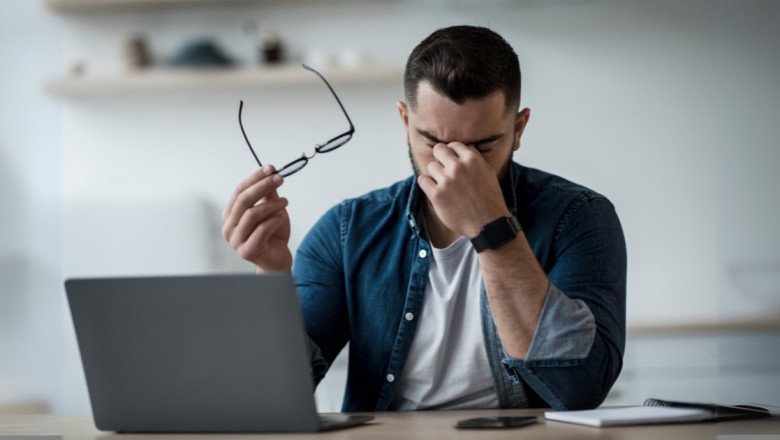views
Workplace Eye Wellness Day 2025 is more than just another date on the corporate wellness calendar—it's a wake-up call. Our eyes, the unsung heroes of productivity, endure endless hours of screen exposure, harsh office lighting, and insufficient breaks. Yet, eye health is often neglected, dismissed as a minor inconvenience rather than a crucial component of overall well-being.
A world increasingly dominated by digital screens demands that we prioritize vision care like never before. From minor discomforts like dryness and irritation to serious conditions such as digital eye strain, neglecting eye health can impact both performance and quality of life. This guide provides practical, science-backed tips to ensure that your eyes stay refreshed, resilient, and ready to take on the workday.
The Hidden Toll of Modern Work on Eye Health
The average office worker spends nearly eight hours a day staring at a screen. This prolonged exposure wreaks havoc on eye health, leading to Computer Vision Syndrome (CVS)—a condition marked by dryness, headaches, blurred vision, and neck pain.
Poor lighting, excessive screen brightness, and a lack of eye-friendly office ergonomics compound the issue. Add in constant exposure to air-conditioned environments that dry out the eyes, and it becomes clear why so many professionals end their workdays with sore, fatigued vision.
Recognizing the Symptoms: Is Your Vision Suffering?
Your eyes often send distress signals long before significant issues arise. Some of the most common symptoms of workplace-induced eye strain include:
- Frequent headaches that begin at the temples
- Difficulty focusing on text or images
- Burning, dry, or watery eyes
- Increased sensitivity to light
- A lingering sense of fatigue, even after adequate sleep
Ignoring these symptoms can lead to long-term vision problems. If discomfort persists, consulting an optometrist is crucial.
Practical Steps to Reduce Eye Strain
Prevention is key when it comes to workplace eye health. Simple yet effective adjustments can make a world of difference:
- Follow the 20-20-20 Rule: Every 20 minutes, look at something 20 feet away for 20 seconds to reduce strain.
- Adjust screen settings: Reduce brightness to match room lighting and increase font size to minimize squinting.
- Position screens correctly: Your monitor should be an arm’s length away with the top of the screen at or just below eye level.
The Role of Nutrition in Eye Health
A well-balanced diet plays a surprising role in maintaining strong eyesight. Nutrient-rich foods like:
- Carrots, sweet potatoes, and spinach (rich in Vitamin A for night vision)
- Salmon, walnuts, and flaxseeds (packed with Omega-3 fatty acids to combat dryness)
- Citrus fruits and bell peppers (high in Vitamin C to protect against eye damage)
Additionally, drinking plenty of water prevents dehydration, which contributes to dry, irritated eyes.
Blue Light and Its Impact on Work Productivity
Blue light, emitted from screens, is a silent saboteur of both eye health and sleep quality. Excessive exposure can disrupt melatonin production, making it harder to fall asleep and stay rested.
Combat blue light exposure by:
- Using blue light filtering glasses
- Activating night mode or blue light reduction settings on devices
- Limiting screen use at least an hour before bedtime
Ergonomics for Eye Wellness
An optimal workstation isn’t just about posture—it plays a key role in reducing visual strain. Consider:
- Anti-glare screen protectors to minimize reflections
- Soft, ambient lighting rather than harsh fluorescent lights
- Proper desk height to keep the monitor at eye level
Simple ergonomic tweaks can transform a strain-inducing setup into a vision-friendly workspace.
Easy Eye Exercises to Relieve Fatigue
Just like stretching alleviates muscle stiffness, eye exercises reduce tension:
- Eye rolling: Slowly roll your eyes in circles to improve circulation.
- Palming: Rub your hands together to create warmth, then place them over your closed eyes for relaxation.
- Focus switching: Shift focus between near and far objects to strengthen eye muscles.
Practicing these exercises a few times a day can work wonders for eye comfort.
Workplace Policies for Better Eye Care
Companies can play a role in protecting employees' vision. Effective strategies include:
- Mandatory screen breaks to prevent prolonged exposure
- Access to anti-glare equipment and adjustable lighting
- Corporate wellness initiatives that promote regular eye exams
Encouraging a culture of eye health benefits both employee well-being and productivity.
How to Participate in Workplace Eye Wellness Day 2025
Mark the occasion by:
- Organizing eye care workshops and awareness programs
- Offering comprehensive eye check-ups for employees
- Promoting workplace-friendly eye wellness habits through internal campaigns
Spreading awareness ensures long-term benefits beyond a single day of observance.
Conclusion
Workplace Eye Wellness Day is a reminder that healthy eyes lead to a happier, more productive workforce. We can all create a healthier, more comfortable work environment by incorporating simple habits, adjusting workspaces, and advocating for better eye care policies.
Your eyes work tirelessly—it's time to return the favor.














Comments
0 comment